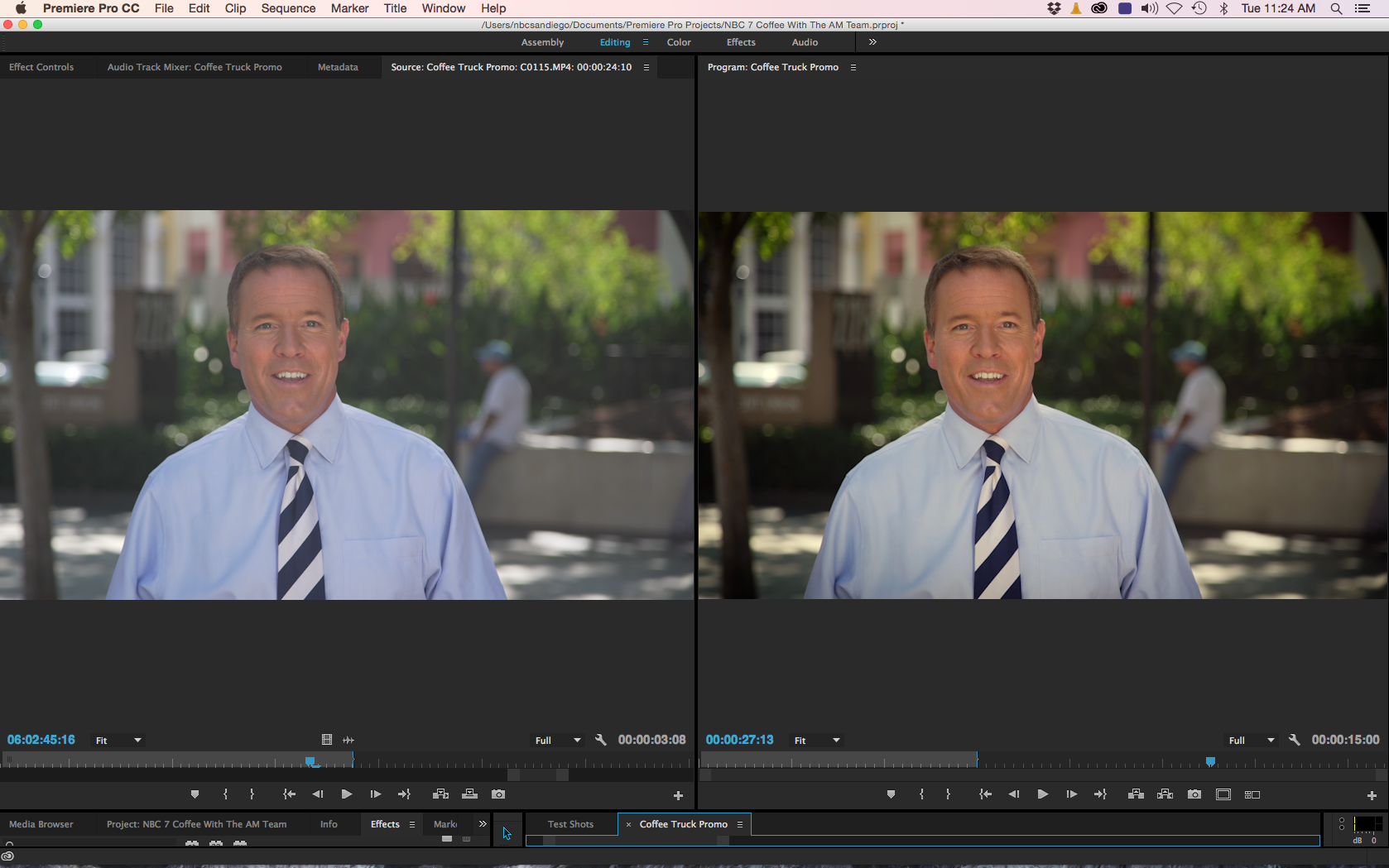You Don’t Have to Shoot Log all the Time. Right?
Lately I’ve been asking myself why do I always shoot in log mode? Yes more dynamic range is nice but in low contrast situations is it really necessary? So I decided to go for a more baked in look with the original Sony a7s for situations that don’t need to be so flat and makes post work longer. Don’t get me wrong. I enjoy color grading a lot but if I can get a nice image without shooting LOG this might be beneficial. The a7s with Slog has a green cast to it that requires even more work in post.
I wrote about a new profile I liked using that is accurate for color but not so flat and here is the results of this look in a promo I just finished shooting and editing with the original Sony a7s. The first anchor in the video was shot with the new A7s II in 4K with a diffrent profile I’m working on. More on that soon but on the a7s II I like CINE 3 and the Still color profile. Yep “still”. It’s the most accurate profile for color I found so far.
The image was easy to grade. The blacks are lifted a little so that gave me the option to see in the shadows more or darken them up. CINE Gammas are very good for this. CINE 1 is flatter than CINE 3. They kind of get more contrasty as you go up to CINE 4.
Here is the breakdown of the Gamma settings for the Sony a7s II. It has a few new ones.
Gamma
| Movie | Standard gamma curve for video |
| Still | Standard gamma curve for still images |
| Cine1 | Softens the contrast in darker image areas and emphasizes gradation changes in lighter image areas, producing a subdued tone overall (equivalent to HG4609G33)Gamma curve that obtains a dynamic range of 460% when the exposure is adjusted to 33% video output with 18% reflectance gray. The maximum value of video output is 109%.Images shot with this gamma can be used without grading, but since the images have smooth gradation characteristics, this can be used to grade and finalize the viewed image in the post-production process. |
| Cine2 | Similar results to [Cine1] but optimized for editing with up to 100% video signal (equivalent to HG4600G30)Gamma curve that obtains a dynamic range of 460% when the exposure is adjusted to 30% video output with 18% reflectance gray. The maximum value of video output is 100%. |
| Cine3 | Stronger contrast between dark and light image areas and greater emphasis on black gradation changes (compared to [Cine1] and [Cine2]) |
| Cine4 | Stronger contrast than [Cine3] in darker image areas |
| ITU709 | ITU709 gamma curve (low-light gain of 4.5) |
| ITU709 (800%) | Gamma curve for checking scenes recorded using [S-Log2] or [S-Log3] |
| S-Log2 | [S-Log2] gamma curve. This setting is selected when some grading work will be performed after recording.The exposure is set so that 18% reflectance gray video is output as 32%. Under these conditions, a dynamic range of 1,300% is obtained with 90% reflectance white. |
| S-Log3 | [S-Log3] gamma curve with characteristics closer to those of film. This setting is selected when some grading work will be performed after recording.It allows for better reproduction of gradations in shadows and the mid-tone range than S-Log2.The exposure is set so that 18% reflectance gray video is output as 41%. Under these conditions, a dynamic range of 1,300% is obtained with 90% reflectance white.
|
Color Mode
| Movie | Color tones for [Movie] gamma curve (standard color reproduction for movies when Picture Profile is not used) |
| Still | Color tones for [Still] gamma curve (standard color reproduction for still images when Picture Profile is not used) |
| Cinema | Color tones for [Cine1] and [Cine2] gamma curve |
| Pro | Color tones similar to standard Sony broadcast camera image quality (used in combination with [ITU709] gamma curve) |
| ITU709 Matrix | ITU709 color tones (used in combination with [ITU709] gamma curve) |
| Black & White | Sets the saturation to 0 for recording in black and white |
| S-Gamut | Setting based on the assumption that some grading work will be performed after recording. Used when [Gamma] is set to [S-Log2]. |
| S-Gamut3.Cine | Setting based on the assumption that some grading work will be performed after recording. Used when [Gamma] is set to [S-Log3].
|
| S-Gammut3 | Setting based on the assumption that some grading work will be performed after recording. Used when [Gamma] is set to [S-Log3].
|
Making things simple has other advantages other than post. I can see the image in my monitor without using a LUT making it easier to focus and just getting a better feel if what I’m actually shooting is color accurate. Most issues with color happen with a bad white balance so I recommend nailing it from the get go. Shoot a chart like the X-Rite ColorChecker Passport as a safety. These come in handy big time.
Another thing about shooting LOG that can be problematic is the 8bit 4:2:0 thingy. Slog is very flat. You have to either use a LUT or grade from scratch and you need to know how or it will take forever. LUTS are great but use the wrong one and again. Trouble and time lose. Every time you move saturation up or change color balance you are degrading the image and adding noise. Yep and that 8bit 4:2:0 codec can only take so much until it breaks. It might look good now but when you go to compress it for the web the image could and probably will break and noise and banding are now apart of the video. Ugh! Capturing the color balance and exposure right from the start will help. Leaving some room for editing or grading is a great idea. Don’t crush the blacks because if you do then you cant get them back. Lift the shadows to much and it get noisy. Leave some room and you can decide to bring the shadows down without making it really hard to balance.
So next time ask yourself. Do I need to shoot this in LOG? Maybe the answer is no and in a lot of cases the difference wont be noticed in the finale edit and you just saved yourself a lot of work in post.
Follow me on Twitter @eriknaso and check out my page on Facebook.
Thanks for coming by! Please help support my site by using the links on this page or bookmark these from my favorite retailers, B&H, Adorama, Zacuto, Amazon.com & Think Tank Photo Using the links cost you nothing extra, but it helps offset the cost of running my blog. Thanks again for coming by eriknaso.com!
Interested in buying a new camera? Well I have a course on Lynda.com you should watch that will help you pick the right one for the job.
Filed in: A7s • A7s II • Featured Post • Mirrorless • Post Production • Premiere Pro












I shoot with a Nikon D800 (and sometimes a Canon 5D mkIII) and gave up trying to shoot with a “flat” picture. I decided to spend an entire Saturday in the studio shooting with different settings and then going into the edit suite to find an optimal setting. I just bake the look into the file now.
I want to thank you for wiring this. I’m NEW to Sony and getting accustomed to the a6300 which I purchased strategically for video. I REALLY like it so far. Posts like this one are giving me the tools and information I need to get up to speed in my workspace and intentions for this camera. I too like grading although I’m not great at it.. but it feels GREAT to have that flexibility in post-production. I’ve yet to find my favorite color profiles according to my shooting/editing style, but you’ve gotten me a couple steps closer.
Thanks Erik, coming to grips with shooting video on an A7RII this is very helpful as I am also looking for a non Log profile that can be tweaked a bit but also looks good staright out of the camera. The reason I got the A7RII for video is I am very happy with the results I have got out of my A7II for stills including the colors. Nobody but you is crazy enough to suggest using the “stills” color profile for video. However when I look at test shots with different profiles I like the “stills” profile more than the others – though I fear it is a narrower gamut so maybe leave less room for tweaking later than the cinema profile. So would like to ask your opinion on what I would lose by shooting video with “stills” color profile compared to other profiles?
Shooting in log does not extend your dynamic range
It sure does
10 and 12 bitrate are the things giving you the extra mile, not log.
I’m disillusioned with log, for a few reasons. I only have experience with C-Log.
1. Exposure is trickier with log! With most cameras/monitors, many exposure tools, like zebras and false colour, are only really useful for a non-log image.
2. With log, you’re seduced into exposing to the right, because your waveform tells you you can, and then in post you may find that your skin tones have less detail than they should have.
3. With log, you can’t feel the image, like Erik says, so you’re stunted in your ability to apply on-set adjustments to enhance the image. Now, I thought it might be possible to get around this problem by using a monitor that takes LUTs. But even then, I find that what I’m looking at is not entirely representative of what I end up with.
4. All of the pushing and pulling of a log image that you’re doing in post may come at a cost in image quality. For C-Log, when the 1DC first came out, a number of people complained that they could never get the colours as vibrant as they wanted them, compared to a normal picture profile.
5. Ok, this is something I DON’T fully understand, and would love to hear more from an expert on. With a C100, say, maybe log lets you shoot with 12 stops of dynamic range. But will you then be limited by, for instance, colour space and display device from showing off all those stops? I’ve got a feeling you might be. So if you want to shoot with one eye on the final product/audience, you might be better off lighting things to bring everything within a smaller dynamic range than just looking at your log waveform, seeing that there’s no clipping, and assuming everything will be alright. Cf. the Zacuto camera shootout from a couple of years ago when a lot of people thought a Panasonic DSLR looked the best, mainly because of the way the scene was lit.
6. And, of course, log can take more work in grading, which is what Erik’s article is all about, but I actually consider that the smallest problem compared with the above.